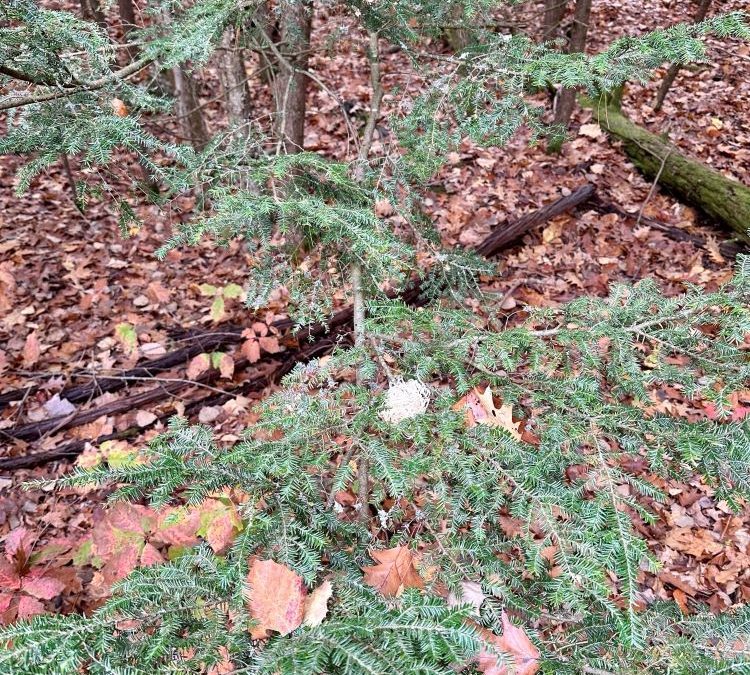Biological control, or biocontrol, is a helpful tool for long-term invasive species management. Biocontrol is when a natural enemy is used, such as an insect or parasite, to control a target pest species. This management strategy has been used for many invasive species, including hemlock woolly adelgid (Adelges tsugae, HWA)
Hemlock woolly adelgid is an aphid-like insect that threatens native hemlocks. This pest inserts its straw-like mouthparts directly into twigs to feed on hemlocks, and disrupts the flow of water and nutrients in the tree. As HWA feeds and grows it starts to accumulate wool, which is where the name comes from. The white, cotton-like woolly masses are located at the base of the hemlock needles, where the needles attach to the twig. The wool protects the adelgid from the colder winter temperatures and forms an ovisac where the adelgid will lay eggs during spring. In summer HWA goes through a stage of dormancy known as aestivation when its mouthpart is still inserted into the twig, but it does not actively feed or grow at this time. In this stage HWA can be observed with a hand lens and appears like black sesame seeds at the base of needles, and may have a halo of white wool.
The eastern hemlock (Tsuga canadensis) is a foundation species in our mixed northern hardwood forests. It is a conifer with low hanging branches, which creates habitat for animals and conserves heat in cold temperatures and windy conditions. Hemlocks are often found in riparian zones and help stabilize streambanks, control water temperature and assist with stream oxygenation. Hemlocks along shorelines and streams can help prevent sedimentation and filter out pollutants. In addition, hemlocks are beautiful trees when they are healthy and have a full canopy. When hemlock tree death is seen, fallen trees can block hiking trails and be a threat to homeowners if trees are located near structures. HWA does not kill hemlocks immediately, but over the next 10 – 20 years, this native tree species could experience great decline if we do not act quickly.
Biocontrol of HWA is an option that can provide long term management and help save hemlock trees in the region. Currently there are two biocontrol options available for HWA. One is the Laricobius beetle which feeds on developing HWA throughout fall and winter. The other option is the Leucotaraxis silver fly which preys on HWA eggs throughout the spring egg-laying season.
In order to release HWA biocontrol in an area, hemlock trees must be surveyed to collect data on tree health and HWA presence, density and distribution. To survey for HWA, be on the lookout for hemlock stands along trails as you enjoy winter recreational activities. Look for a hemlock that has low hanging branches that you can easily examine. The HWA can be seen on the underside of the branch, and may be present on branches that have fallen off the tree and are on the ground as well. Look for the characteristic wool, which appears as white, cotton-like, woolly masses clumped on hemlock twigs near the base of the needles. Additional information about HWA survey efforts can be found on WNY PRISM’s HWA Hunters webpage, www.wnyprism.org/programs/community-science/hwa-hunters/.
In November 2023, WNY PRISM joined the New York State Department of Environmental Conservation and the New York State Hemlock Initiative to release HWA biocontrol in Zoar Valley Multiple Use Area at Valentine Flats. The group released 1700 Laricobius nigrinus beetles. These beetles were released on hemlocks with HWA infestations so they can easily find their way to the HWA and feed on it. This beetle is a specialist predator that feeds exclusively on developing and adult HWA throughout the fall and winter seasons. It was exciting to join a biocontrol project to see exactly how the beetles are released onto the trees. We learned about the specific packing material used to transport the beetles and how to pick ideal trees to place the beetles in. It felt good to have this hands-on experience in a process that will help protect our hemlocks!
One survey technician, Lindsay Piotrowski, will focus on hemlock stand assessment and HWA data collection as her master’s project. From January – March 2024, Lindsay will visit sites in the WNY PRISM region and collect data with the Survey123 Forest Pest Collection Form. These in-depth site assessments will help determine new sites for biocontrol release. Be on the lookout for future biocontrol updates in our region!
Blog post written by Jason Kappan and Lindsay Piotrowski, Invasive Species Survey and Monitoring Technicians.


